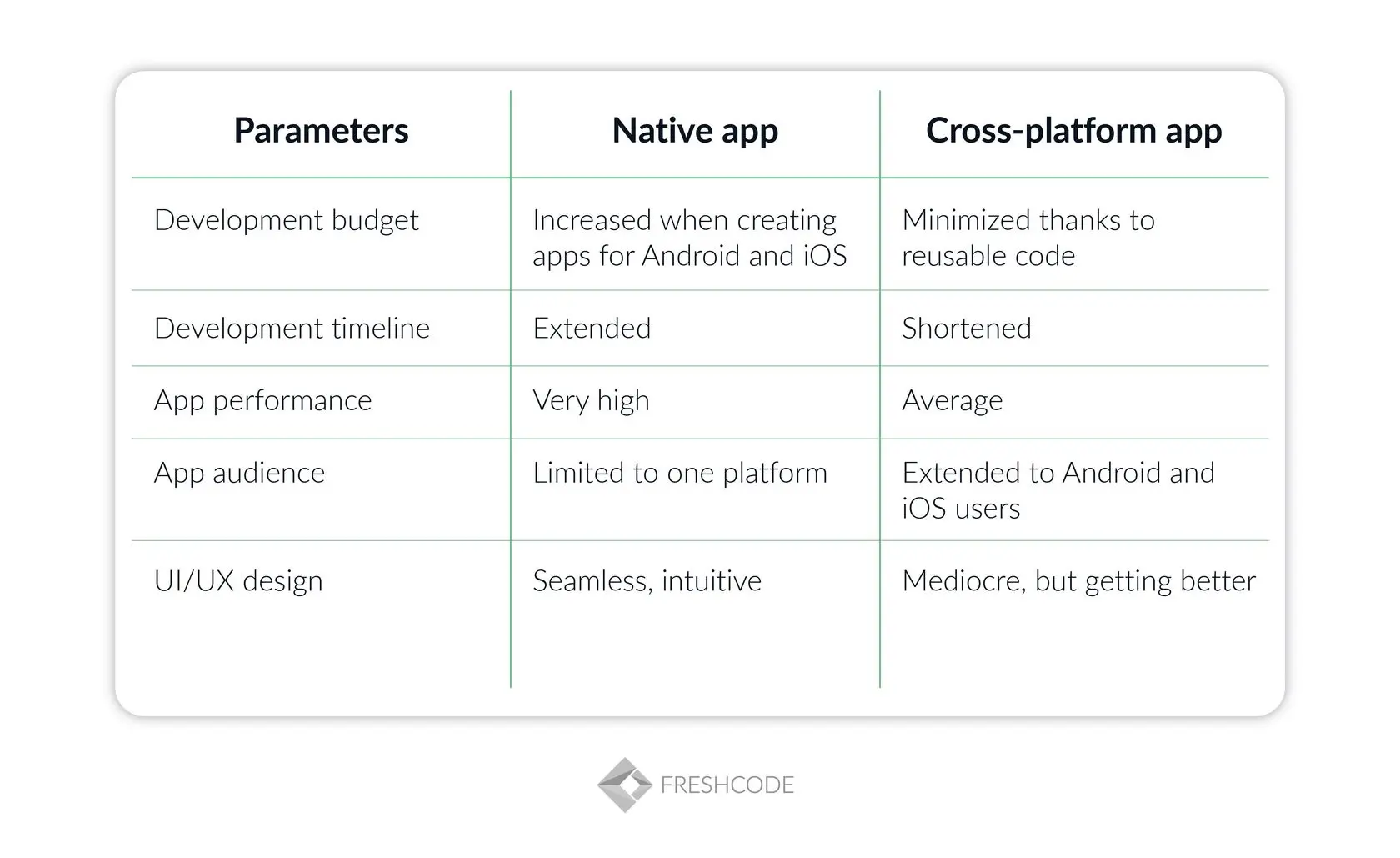Cross-platform vs. native app development
- <medium>Native app development<medium> is suitable for Android and iOS, as well as other mobile operating systems. The development team relies on a platform-specific technology stack that is unsuitable to any other OS. Creating native apps for different platforms calls for twice as many software engineers or twice as much time. The expenses double up too. However, native apps are tailored to make most of the platform-specific hardware, such as cameras or geolocation tools. Being attuned to a particular OS makes native applications faster and more intuitive.
- <medium>Cross platform development<medium> works through frameworks that make the app adjust to various platforms on the fly. The development team needs only create the core code that can be used for Android and iOS, making the whole process more efficient and affordable than native development. The first cross-platform frameworks sacrificed performance and design to accelerate development, but their current alternatives are getting better at making apps look and feel native.

The core benefits of cross platform apps development
Some advantages of cross-platform software become obvious the moment you realize its differences from native development. However, there are a few considerations startups founders and business owners overlook. Yet these benefits can be vital to your business survival, and they include:
{{blognn4-1="/custom-block-to-blog/three-page"}}
How to choose among cross paltform frameworks?
As cross platform apps gain traction, making sense of the technologies on offer becomes challenging. With plenty of features, synchronizations, and integrations to account for, you have to rely on the technology stack suggested by the development team. Or you can do your homework, research the common options, and pay attention to four critical parameters:
{{blognn4-2="/custom-block-to-blog/three-page"}}
Based on years of cross platform app dev and the parameters we've discussed, we have selected five solutions that can help you reap the benefits of creating a cross platform application.
{{blognn4-3="/custom-block-to-blog/three-page"}}
Top 5 cross platform mobile development solutions
React Native
This Facebook-backed open-source platform has been gaining popularity since its inception in 2015. React Native relies on JavaScript, React, and native development tools to create declarative UI components and combine them in complex interfaces that look and feel nearly indistinguishable from native apps. This framework has already surpassed Xamarin in popularity and is among the most commonly used solutions for creating cross platform apps from scratch.

<medium>pros:<medium>
- Near-native performance and UX design
- Mature community support
- Suitable for complex interfaces and features
<medium>cons:<medium>
- Bug fixing may be complicated by the framework structure
- Native tools expertise needed for high-quality development
Flutter
Created in 2017, Google-backed Flutter is becoming the most fast-growing among cross platform frameworks. The open-source solution comes with immaculate documentation and plenty of code reuse capabilities, though the libraries are still lacking. Considering Google's heavy investment in this technology, it remains highly stable and will probably continue to gain popularity in the coming years. It's an excellent choice for complex apps that are being created from scratch.

<medium>Pros:<medium>
- Extremely high performance
- Near-native user interface design and experience
- Highly reusable code across web, desktop, mobile
<medium>Cons:<medium>
- Limited libraries
- Few Flutter developers with an iOS background
Xamarin
Created in 2011 and supported by Microsoft, Xamarin is an open-source platform, though it comes with paid packages too. It's a perfect choice for a team of C# and .NET developers, and it boasts high performance and elaborate design capabilities comparable to native apps. Integrations with native APIs and libraries extend Xamarin's toolset, and it's perfect for pairing with a Microsoft-powered backend.

<medium>Pros:<medium>
- Near-native user experience and performance
- Suitable for mid-sized business apps
- Native libraries and APIs integrations
<medium>Cons:<medium>
- Source code not reusable for web apps
- Xamarin.Forms performance is lagging
Adobe PhoneGap
PhoneGap is perfect for simple apps displayed as a single-page website in a built-in browser and made to look native. The framework requires knowledge of HTML, CSS, and JavaScript, but can also call for experience with native tools, like Java or Objective C. We would not recommend using this technology for complex cross platform apps that lean heavily on using smartphone or tablet interface elements.

<medium>Pros:<medium>
- Reusable source code, even for web apps
- No additional costs
- Can be integrated with any backend
<medium>Cons:<medium>
- Browser and wrapper layers hinder performance
- Bug fixing is complicated by additional layers too
- PhoneGap's popularity is waning, along with Cordova
Appcelerator
Appcelerator Titanium is the newest addition to the cross-platform framework family, and it comes with a few significant differentiators. For one, it relies on JavaScript and a visual drag-and-drop app building interface, expediting the development timeline. The built-in notifications features are also a nice touch. However, you won't be able to test most of the features, including crash analytics, with a free plan, and the premium rates start at $199 per seat per month.

<medium>Pros:<medium>
- Easy-to-use drag-and-drop interface
- Built-in notification features
- Rich mobile analytics toolset
<medium>Cons:<medium>
- The free plan has limited functionality
- Suitable for simple interfaces only
Final thoughts
For all its benefits, cross platform mobile app dev is not a one-size-fits-all solution. This approach lowers expenses and accelerates development, making maintenance less challenging in the long run. And while cross platform frameworks are gaining popularity and becoming better at imitating native design and performance, there's still room for improvement. Choosing among the five frameworks we've shortlisted should help you minimize the risks and squeeze maximum business value from building your first cross platform app.
Check out Freshcode development services to stay ahead of the future tech challenges. Here you can book a free consultation.
{{about-bar-kos-green="/material/static-element"}}









